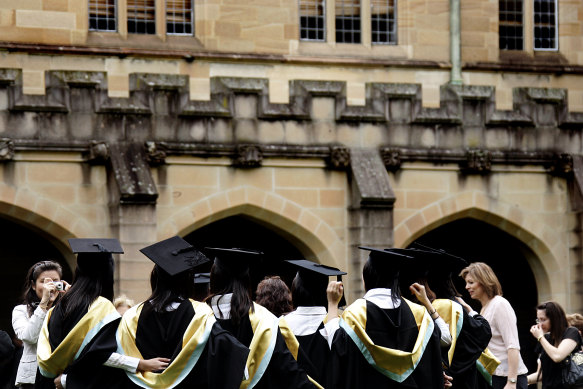Key points
- A new longitudinal survey found the gender pay gap among Australian university graduates has more than doubled from $2400 in 2019 to $5700 in 2022.
- The University of Melbourne was the second-lowest placed university in the country on medium-term salaries, with graduates earning a median $73,200 a year.
- Five of eight public Victorian universities had employment outcomes above the national average.
The gender pay gap among Australian university graduates has more than doubled since the start of the pandemic, with male graduates earning an average of $5700 a year more than women this year, up from $2400 in 2019.
A major survey of graduates has found that three years after graduating, women are significantly lower-paid than men in many popular fields of study, with salary gaps of $12,400 (15 per cent) in architecture, $6300 (7.6 per cent) in nursing and $6000 (6.5 per cent) in engineering.
Employment outcomes for university graduates are at a 10-year high, but the gender pay gap has grown.Credit:Rob Homer
Women graduates are better paid in a small number of fields, and by smaller margins, including in medicine ($1800 a year), and computing and IT ($600 a year).
The 2022 graduate outcomes longitudinal survey, taken in February, also found that Victorian university graduates lag the national average on pay, with medium-term graduates from the state’s highest-ranked university, the University of Melbourne, among the lowest-paid in Australia.
Employment outcomes for graduates have rebounded to their strongest level in a decade this year after dipping in the first two years of the pandemic. More than nine in 10 people who graduated in 2019 have found full-time work.
Five out of eight public Victorian universities had employment outcomes above the national average.
Nationwide, 90.3 per cent of people who graduated in 2019 had found full-time work by this year, a result bettered by Monash (93.9 per cent); Deakin (91.6 per cent); Federation (91 per cent); La Trobe (90.8 per cent); and Melbourne (90.8 per cent). RMIT, Swinburne and Victoria universities recorded results below the national average.
But Victorian graduates fared less well on pay, with medium-term salaries for those with undergraduate degrees mostly below the national average.
The median full-time annual salary in February was $80,000 for medium-term graduates: $84,000 for men and $78,300 for women.
Only Monash and Swinburne equalled the $80,000 mark. The other six Victorian universities reported lower salaries among medium-term graduates.
The University of Melbourne was the second-lowest-placed university in the country on medium-term salaries, with graduates earning a median of $73,200 a year.
The report categorised medium term as three years after graduating.
Lisa Bolton, a director in research and strategy at the Social Research Centre, said Victorian female students fared slightly better than the rest of the country in terms of the gender pay gap.
In 2022, male undergraduates earned $3000 more than women in the short term ($63,000 to $60,000) and $5100 more in the medium term ($80,000 compared with $75,100).
Across the country, there is a gender pay gap of $2700 in the short term ($65,700 to $63,000) and $5700 in the medium term ($85,000 to $79,300).
Bolton said the study demonstrates how women are more likely to have interrupted work over time.
“Women are having children between the ages of 25 and 44. They are less likely, therefore, to have promotions and less likely to move into managerial roles,” she said.
According to the Workplace Gender Equality Agency, even though more women than men graduate from higher education institutions and receive the same education, women continued to be undervalued in the majority of fields from the beginning of their careers.
The agency’s director, Mary Wooldridge, said the data shows that women’s work is valued less than men’s, even for those with higher qualifications, and that the disparity grows over time.
The current gender pay gap according to WGEA is 22.8 per cent. Wooldridge said they were working to close this gap.
Bolton said employment and wage outcomes come down to a range of factors, including a university’s profile, location and labour market force, its focus on vocational areas, such as nursing, its links with employment opportunities, and its online offering.
She said big online universities were likely to have high employment rates because students worked and studied at the same time.
The Morning Edition newsletter is our guide to the day’s most important and interesting stories, analysis and insights. Sign up here.
Most Viewed in National
From our partners
Source: Read Full Article

